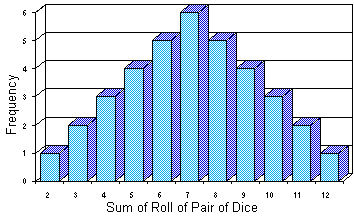
The manual simulations described here rely on the use of dice
to create data that mimic the types of information you might collect
in certain research situations. Essentially all you need to complete
these exercises is a pair of dice, several different colored pens
or pencils, and some paper. You should begin these exercises
with the first one, Generating Data. You cannot do the subsequent
exercises without doing this one first, because you will use the
data generated in the first exercise as the basis for all the
others. For the most part, it is best if you go through the exercises
in the order presented, although you may skip exercises if desired.
While there are advantages to using dice to simulate data, there
are also various shortcomings. Rolling dice can take some time.
In the time it takes you to roll and record the value of a pair
of dice, most computers can create hundreds or even thousands
of random numbers. But manual simulations allow you to observe
carefully how a simulation is constructed. There is a certain
tactile quality to them that cannot be equaled on a computer.
This is especially valuable for students who are new to simulation
or to the research design topics covered here. Because dice rolling
takes considerably longer than computer data generation, the total
number of cases you can create is limited. Simulations work best
-- show results most clearly -- when there are more cases rather
than fewer. Consequently, the results you obtain may not be as
clear from these manual simulations as from the computer ones.
Because of this limitation, it would be desirable for you to
do these manual simulations in concert with others, perhaps in
connection with a class you are taking or with a group of friends
interested in social research methods. After completing each
exercise you can compare results to get a clearer picture of whether
your data patterns are typical or more unusual.
Another disadvantage of dice rolling for generating data is in
the distribution that results. Much of the statistical analysis
in contemporary social research assumes that the data come from
a normal or bell-shaped distribution. The roll of a pair of dice
approximates such a distribution, but not exactly. In fact, the
distribution of a pair of dice is a triangular one with a minimum
value of 2, a maximum of 12, and an average of 7. You can see
that by looking at a table of all possible sums of a pair of dice
shown in Table 1.
You can see the theoretical distribution that results in the histogram
in Figure 1. While this is not exactly a bell-shaped curve, it
is similar in nature, especially in that it has its highest value
in the center of the distribution, with values declining in frequency
towards the tails. For all practical purposes, this difference
in distribution has no effect on the results of the manual simulations.
However, if you tried to use dice to generate large amounts of
data for analysis by statistical procedures that assume normal
distributions, you would be violating that assumption and might
get erroneous results.
In these manual simulations, we have kept statistical jargon to an absolute minimum. We don't require you to calculate any formal statistics beyond an average. For many statistical analyses common in social research, we have you try to estimate what you would get. For instance, we have you try to fit a straight line through a pre/post data plot by hand. In statistical analysis (and in the simulations in part two) we would fit a regression line. We don't have you calculate statistical formulas in these exercises because the calculations would often be cumbersome and time-consuming and would most likely detract from your understanding of the simulation principles involved.

However, you could do the calculations on your own or by entering
the dice rolling data into a computer for analysis.
One of the advantages and distinct pleasures of doing simulations is that they allow you to experiment with assumptions about data and find out what happens. Once you have completed the manual exercises, we encourage you to use your creativity to explore assumptions that you find questionable. Making up your own simulations is a relatively simple task and can lead to greater understanding of how social research operates.